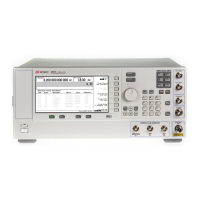E8257D/67D, E8663D PSG Signal Generators Service Guide
Troubleshooting
Overall Description
1-87
Output Power Level/Automatic Leveling Control
The output power control circuitry, commonly referred to as the ALC loop, comprises the following:
• Two detectors: the A23 Lowband Coupler/Detector (frequencies ≤2 GHz) and the
A24 Highband Coupler/A25 Highband Detector (frequencies >2 GHz). Note: this is not the same frequency
breakpoint as defined by the lowband and highband paths.
The couplers couple off a small portion of the RF signal and route it to the detectors. The detectors convert the
RF signal to a dc voltage proportional to the RF power level. This dc voltage is routed to the A10 ALC and used
to adjust the output power.
• An ALC assembly (A10)
• Two ALC modulators
In ALC leveling on (closed loop operation), the output level is detected and a voltage fed back and compared to a
reference voltage. The output of the comparator controls the modulator drive current, which controls the output power
level. When the detected and reference voltage levels are the same, the modulator drive current remains constant.
When the detected and reference levels are not the same, the modulator drive current changes, causing the RF output
power to increase or decrease until the reference and detected voltages are the same.
In ALC leveling off (open loop operation), only a reference voltage is used to control the modulation drive current.
The comparator output is the sum of the reference voltage and stored calibration data for that frequency point; no
feedback is provided. The stored calibration data is correction information stored in the instrument during power level
calibration; it adjusts for any losses that occur after the coupler/detector. The reference voltage is generated on the
A10 ALC by a DAC, the output voltage of which is the result of the power level set on the front panel.
Leveling during ramp sweep (Option 007)
In ramp sweep mode, a sweep compensation reference voltage is routed from the A9 YIG Driver assembly to the
A10 ALC to improve leveling during sweep operation. The A18 CPU controls the ALC reference correction DAC on the
A9 YIG Driver.
Analog Modulation (Option UNU Standard Pulse, UNW Fast Pulse, UNT AM/FM and Phase Modulation)
All modulation functionality is license keyed. Without a license key entered into the instrument, the instrument will
not provide any pulse, amplitude, frequency, or phase modulation. Two levels of pulse modulation performance are
offered. Pulse Option UNU provides pulse widths of 150 ns or greater for frequencies at or above 3.2 GHz, 500 ns or
greater for frequencies below 3.2 GHz, and with ALC off or in search mode, 1 ns or greater for frequencies at or
above 3.2 GHz, and 2 ns or greater for frequencies below 3.2 GHz with ALC on. Pulse option UNW provides pulse
widths of 20 ns or greater for all frequencies with ALC off.
The RF can be modulated using either external or internal signals from the A11 Pulse/Analog Generator. The
A11 Pulse/Analog Generator includes a pulse generator and a numeric synthesizer that provides AM, FM, PM, and
pulse modulation capabilities. For better phase modulation control, the internal generator is tied to the A7 Reference
10 MHz.
Internally generated signals up to 1 MHz can be switched to the LF Output BNC on the front panel.
A11 Pulse/Analog output signals are routed as follows:
Digital Modulation
Digital I/Q modulation is generated on the A8 Lowband Vector Output and A35 3–20 GHz I/Q Modulator assemblies.
The A13 I/Q Multiplexer routes the I/Q modulation to the A8 and A35. The source of the modulation may be provided
externally via the front panel I/Q inputs or via the rear panel Wideband I/Q (Option 015) inputs. For signal generators
with Option 601 or 602, the internal A14 Baseband Generator may be used as the source of the I/Q modulation. The
A13 I/Q Multiplexer also routes the baseband I and Q, along with their inverses, to the rear panel.
Modulation Type Routed to
Amplitude A10 ALC
Pulse A30 Modulation Filter
A8 Output
A36 Quadraplier
A37 Upconverter
Frequency and Phase A6 Frac–N

